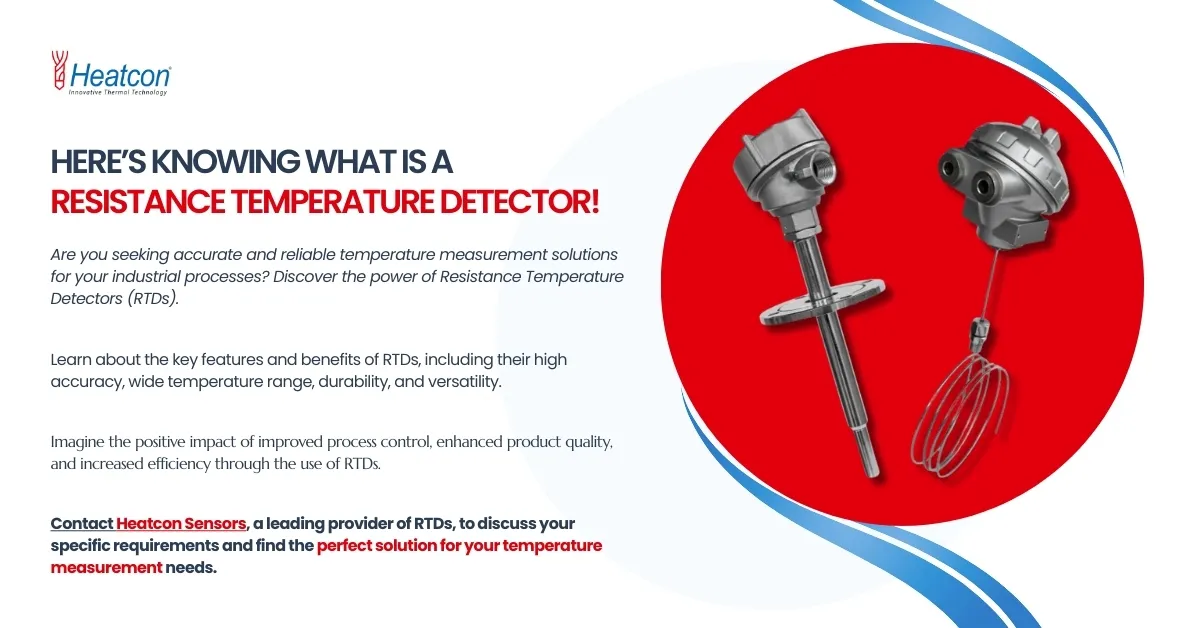In the recent few years, the demand for accurate temperature readings has hit the roof across a myriad of industries. According to a report presented by Grand View Research, the global temperature sensing market has been anticipated to reach a whopping 5.5 billion dollars by the year 2025, which is a growth at a 6.1 percent CAGR. The main contributor to this stupendous growth is the widespread use of Resistance Temperature Detector, or RTD. This sensor is renowned for its accuracy & reliability in temperature measuring process applications. Let us know the answer to the question, what is a resistance temperature detector?.
What Are RTD?
RTD sensor full form is Resistance Temperature Detector. It is basically a temperature sensor, which operates on the principle of electrical resistance alteration with temperature. As the temperature increases, the resistance of the RTD material (typically platinum) increases. The basic construction of an RTD sensor involves a thin wire that’s made of a pure metal, usually platinum, that’s wrapped around a ceramic or glass core. This metal wire is carefully calibrated to give accurate readings of temperature changes.
Understanding RTDs
RTD sensors are mostly used due to their high precision, stability, & repeatability. They can measure temperature ranges from -200 degrees Celsius to +850 degrees Celsius (-328 degrees F to +1562 degrees F) with remarkable accuracy. The RTDs full form (that’s Resistance Temperature Detector) itself clearly suggests that these temperature sensors are based on the resistance principle, which allows for accurate temperature readings across a number of industrial process applications. In contrast to other temperature sensors such as thermocouples, RTDs tend to be far more stable and they also have a linear relationship between temperature & resistance, making them a perfect pick for industries where precision is pivotal.
Resistance Temperature Detector Application
RTD sensor temperature is used in many applications across varied industries. Such applications illustrate the versatility of RTD temperature sensors, making them quintessential components in many fields requiring temperature readings. These applications include the following:
- Aerospace: In different aerospace applications, they are utilised for temperature readings in engines & environmental control systems, where reliability & precision are critical.
- Automotive: In this industry, RTDs are used in various systems, like engine temperature monitoring & climate control systems.
- HVAC Systems: In heating, ventilation, & air conditioning (HVAC) systems, RTD sensors help in maintaining optimum temperature levels, ascertaining energy efficiency & comfort.
- Food and Beverage: These sensors are employed in the food industry for monitoring temperatures during processing, storage, & transportation to ensure food safety and quality.
- Medical Equipment: In medical devices, RTD temperature sensors give accurate temperature measurements for different applications, including patient monitoring systems & lab equipment.
- Industrial Processes: These are extensively used in chemical processing, oil & gas industries, and power generation. Their accuracy & stability make them suitable for monitoring critical processes.
Resistance Temperature Detector Working Principle
The resistance temperature detector working principle is basically based on the fundamental property of metals: which is that – their electrical resistance changes with altering temperature. This principle ensures that RTD sensors tend to give accurate & reliable temperature measurements, making them indispensable in critical applications. Specifically, the relationship between resistance & temperature can be described by the Callendar-Van Dusen equation, which expresses the resistance of the RTD in terms of temperature.
- Temperature Coefficient of Resistance (TCR): Each metal tends to have a specific temperature coefficient of resistance. This indicates how much the resistance changes with a change in temperature. For platinum, which is typically used in RTDs, the TCR is around 0.00385 ohms/degrees Celsius.
- Measurement Circuit: An RTD is usually connected in a measurement circuit that applies a known current to the sensor. The voltage drop across the sensor is then measured, allowing the resistance to be calculated using Ohm’s Law (V=IR).
- Signal Processing: The measured resistance is usually converted into temperature measurements making use of calibration data, ascertaining precise temperature monitoring.
Features of RTDs Provided by Heatcon Sensors
Heatcon Sensors provides a vast range of resistance temperature detector RTDs that cater to a myriad of industrial requirements. Below are some notable features & benefits of our RTD sensors:
- High Accuracy: Our RTDs boast high accuracy levels, making them suitable for applications requiring accurate temperature readings. Our designs minimize errors & enhance measurement reliability.
- Easy Installation: The design of our RTD temperature sensor ensures straightforward installation, which reduces downtime during setup & allows for easy integration into existing systems.
- Calibration Services: We provide calibration services for our RTD sensor temperature tools, ensuring that customers receive sensors that are accurately calibrated to meet industry standards.
- Cost-Effectiveness: While maintaining high-quality standards, we offer RTDs that are competitively priced, making them accessible for varied budget ranges without sacrificing performance.
- Wide Temperature Range: The RTDs that we provide can operate over an extensive temperature range, typically from -200 degrees Celsius to +850 degrees Celsius, accommodating multiple industrial processes without compromising performance.
- Stability & Repeatability: Our detectors provide great stability over time, ascertaining that the readings remain consistent throughout their service life. This repeatability is crucial in maintaining the integrity of industrial processes.
- Robust Construction: Our RTD sensors are designed to withstand harsh industrial environments. They are usually housed inside durable materials, which protect the sensors from damage due to moisture, dust, or mechanical stress.
- Customizable Solutions: We understand that each application has distinct needs. So, we provide customisable solutions, allowing customers to select features such as wire material, insulation type, & sensing element configurations.
- Applications in Diverse Industries: Our resistance temperature detectors are pretty versatile in nature, suitable for multiple applications across different sectors, including pharmaceuticals, food processing, & HVAC systems.
- Technical Support: Customers receive comprehensive technical support from our team, assisting with installation, troubleshooting, as well as optimising sensor performance.
In conclusion, knowing ‘what is resistance temperature detector?’ is crucial to understand what role they play in modern temperature measurement. Their precision, dependability, & versatility make them essential in numerous industries. With Heatcon Sensors’ high-quality RTDs, businesses can ensure optimum performance in their temperature monitoring applications. For further information about Resistance Temperature Detector RTD & how it can benefit your industrial applications, feel free to visit Heatcon Sensors or contact our support team for personalised assistance.


